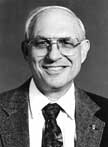by Lee C. Gerhard,
Director and State Geologist

We need to address issues as dispassionately as possible, even when the issues strike home in Kansas
Lately I have
become concerned about the perception and use of science in federal policy
and in the public media. Mars landings, dinosaur discoveries, medical
breakthroughs, and new theories of stellar history make these exciting
times for science and the media that report on science. But sometimes
we forget that science should be objective, unbiased, and accept outcomes
of study without regard to preconceived ideas. Science should work from
multiple theories, evaluating and disproving theory as it progresses.
Therein lies the problem with communicating science to the public—most
of the time there isn’t a single correct answer, almost always there
is uncertainty, and a judgment is required. Sometimes the public media
do not communicate the appropriate degree of uncertainty.
This is particularly important when science impinges upon public policy.
Then media interpretations and political agendas can twist uncertainty
into “politically correct” conclusions. One must carefully
and critically analyze statements that begin with “most scientists
agree” or “we all know.” The Kansas Geological Survey
endeavors to provide unbiased science for policymakers among its other
duties, but in doing so we also try to emphasize the degree of certainty
of our data and interpretations.
We need to address issues as dispassionately as possible, even when the
issues strike home in Kansas. For example, over many years Kansans have
been concerned about the quantity of water available to citizens and industry,
particularly in western Kansas. There is still concern about water availability,
especially for the city of Hays. However, nationally and in Kansas, water-quality
(safety) issues have become a major focus. In the future Kansans will
likely grow increasingly concerned about the effects of confined animal
facilities in western Kansas on the quality of ground water. I expect
considerable public debate over the potential for contamination. This
debate will take place in the public media and the legislature, and will
require good science for resolution.
We encourage all our readers to critically examine what they read in the media, to ask fundamental questions about proof of claims, to question fairness of representation, and to examine interpretations for bias. Are there other explanations for the same information? Ask us questions about what we say, examine our data, question our interpretations—we’ll discuss them with you. We hope all public science will do the same.

The Kansas Geological Survey and the Division
of Water Resources of the Kansas Department of Agriculture will measure
water levels in more than 1,400 wells in western and central Kansas in
early January 1998. The measurements are made annually as part of a program
to monitor ground-water levels, primarily in western and south-central
Kansas. Most of the measured wells are used for irrigation, and many have
been monitored since the 1950’s to study water-level trends. Results
are used by governmental agencies, ground-water management districts,
businesses, and individuals in making decisions about water use.
“Annual measurements are generally made in January, when water
levels have stabilized after growing season irrigation and before spring
irrigation begins,” said Rick Miller, head of the Survey’s
exploration services section. “That gives us a consistent, accurate
set of data, one that provides a snapshot of regional water levels.”
Results of the measurements will be available both electronically and
as a published technical-series report. For each well measured, the report
lists depth to water, changes in water level, and the rock formation that
produces the ground water. The report also analyzes trends in water-level
changes in western and central Kansas. In addition to measuring the wells,
the Survey will use global positioning systems to precisely locate each
well.
Results of the 1997 water-level meaurement program are currently available in Survey Open-file Report 97-34 and on the Survey’s home page. The 1998 measurements should be available on the KGS home page by May 1998.
Online February 10, 2003
Comments to: lbrosius@kgs.ku.edu
Kansas Geological Survey
URL:http://www.kgs.ku.edu/Publications/GeoRecord/1997/vol3.3/Page2.html